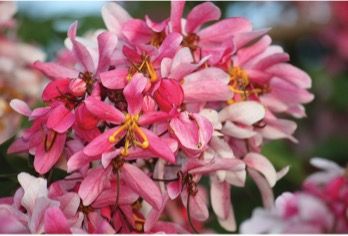Family
Fabaceae or Leguminosae, bean family
Genus
Cassia comes from the ancient Hebrew word “quetsi’oth,” first used by Dioscorides, a physician in Ancient Greece (40–90 AD). Linnaeus, also known as the father of taxonomy, was the first to use Cassia to signify members of this genus.
Species
The species name javanica is the Latin term for Java, where this plant was originally described.

Credit: Jan Smith, CC BY 2.0, http://flic.kr/p/7qjwsN
Common Name
Pink and White Shower, Apple Blossom Cassia
This tree is referred to as “pink and white shower” because it produces pink and white blooms. It is also called “apple blossom cassia” because its dainty pink and white flowers may be easily confused with those of apple trees.
Description
This deciduous tree is native to Southeast Asia and Indonesia. It grows well in tropical regions of the United States such as Florida, Hawaii, and Puerto Rico, as long as it is in well-drained soil with little threat of freezing temperatures. This tree should be grown in direct sunlight for full flower ing potential. With proper pruning, pink and white shower can reach heights of 35–45 feet. The leaves are alternately arranged and are pinnately compound. Each leaflet is oval-shaped, 4–5 inches long, and arranged in 5–12 pairs on a leaf. New woody stems are brown, and the mature bark is light gray with thick vertical sections of dark brown. Small flowers appear at the end of branches in the summer months, and these blooms display different shades of pink and white on the same tree and on the same flower. Fruits are foot-long dry pods.
Allergen
Members of the genus Cassia are moderately allergenic. Oil from the pods may cause skin irritation to some individuals.
Storm Tolerance
Because of its droopy limbs and tendency not to form a strong, single-leader trunk, the pink and white shower tree is not strongly resistant to wind. However, adequate prun ing can help to increase its storm tolerance.
Applications
Horticultural
Cassia javanica is planted primarily as a decorative shade tree. While not as popular as the yellow flowering Cassia fistula or golden shower, many people consider pink and white shower to be aesthetically pleasing because of its pink and white blooms that emerge during the summer months. Although pink and white shower is deciduous, it quickly replaces its leaves. Because its leafless season is so short, many find that pink and white shower is still a desirable shade tree throughout the year. Its rapid growth rate makes it an ideal tree for homeowners looking to increase their tree cover.
Additionally, pink and white shower’s natural resistance to pests increases its desirability as a landscape tree that is commonly used as an ornamental street tree.
Additional References
Gilman, E. F. (1997). Trees for Urban and Suburban Landscapes. Albany, NY: Delmar Publishers.
Stebbins, M. K. (1999). Flowering Trees of Florida. Sarasota, FL: Pineapple Press.
Brown, S. H., and Lans, H. S. (n.d.). Flowering Trees for South Florida. Gainesville, FL: UF/ IFAS Florida Cooperative Extension Service. Retrieved from http://blogs.ifas.ufl.edu/leeco/files/2018/02/FloweringTreesTropical.pdf.